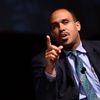"In framing public policy, I not only feel that it would be a mistake to shy away from an explicit discussion of the specific issues of race and poverty but also that we should highlight them in our attempt to convince Americans that there is an urgent need to address them."
These words from Dr. William Julius Wilson, a well-respected scholar who over the last few years has changed his position to now recognize that class and race are barriers to opportunity, underscores the limitations in the recent Associated Press article, "80 Percent Of U.S. Adults Face Near-Poverty, Unemployment: Survey".
Acknowledging that most Americans face increasing economic insecurity is important. But the article's whitewashing of the deep racial economic divide, which is one of the great challenges facing our nation in the 21st century, is disconcerting. Recognizing that for the last several decades our economy has been more focused on building the wealth of the richest in society rather than supporting a broad-based middle-class economy is a step in the right direction. But, unless we want to maintain the nation's historic and contemporary racial economic divide, we must confront the reality of today's racial inequality.
Statements in the article like "race disparities in the poverty rate have narrowed substantially since the 1970s" obscures how African-American poverty is still at disproportionately higher levels than that of whites. It is true that from 1970 until today, the disproportionate number of Blacks in poverty has decreased from being almost 3.5 times that of whites to about three times that of whites. But the country still has far to go before reaching economic parity among racial groups much less attaining the larger goal of ending poverty in the wealthiest nation in the world.
The article also notes that "the number of white mother-headed households living in poverty has risen to the level of black ones." This detail diverts attention from the underlying issue that more people of color are disproportionately economically insecure. While it is accurate that, in total numbers, there are about 1.5 million white mother-headed households living in poverty, a number similar to that of African-American mother-headed households, it obscures the fact that African-Americans comprise only 12.3 percent of the U.S. population compared to the white population at 63 percent. One-point-five million woman-headed households in poverty represents nearly half of black women-headed households while near a third of white women-headed households.
Yet, wealth inequality is perhaps the greatest driver of the racial economic divide. And the racial wealth divide has only been widening. Currently, white families have more than $113,000 in wealth, whereas African-Americans have an average of less than $5,700. To suggest that wealth is the greatest predictor of standardized test scores muddies how wealth and access to wealth building opportunities have been (and continue to be) racialized.
Since the March on Washington for Freedom and Jobs fifty years ago where Dr. King delivered his famous "I Have a Dream" speech, African-Americans have consistently had an unemployment rate twice that of white Americans. Of course, to move the country forward we cannot and should not focus just on one race or ethnic group. But in order to advance the country as a whole we must look at all of her parts. We can do this by ensuring those who have been historically and contemporarily excluded are being fully integrated into rebuilding an American middle-class economy.
